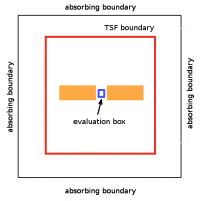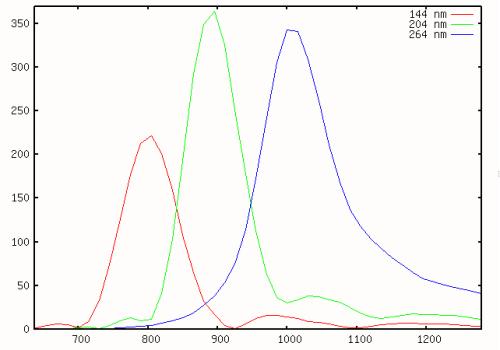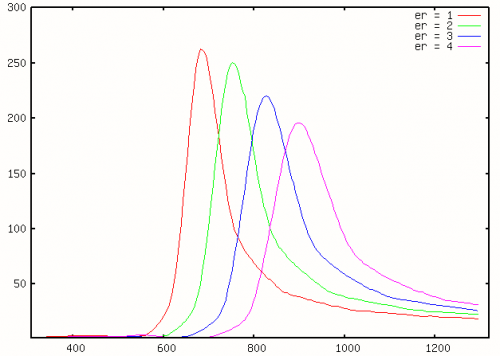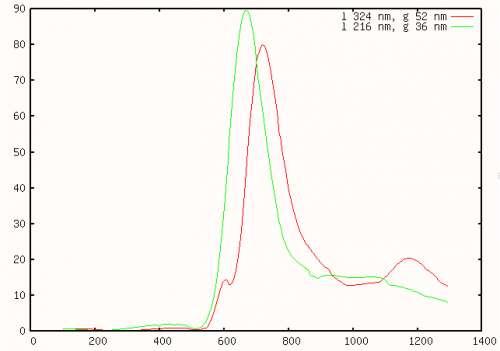User Tools
Sidebar
 Add this page to your book
Add this page to your book  Remove this page from your book
Remove this page from your book Plasmonic nanoantenna
Recently, nano-antennas and nano-antenna arrays became very popular examples of nanotechnology in optics. Small metallic rods or high aspect ratio nanoparticles can be used to enhance locally electromagnetic field of desired wavelength, providing tunable absorption properties or secondary excitation of localised luminescence or Raman scattering. Using realistic metal models we can calculate nanoantennas response using FDTD, which seems to be very popular method in this field. Here we show examples of calculation of spectral dependences of local field enhancement around simple nanostructures, similar to what we have seen in the literature. Results are not compared with experimental measurements directly as we don't have such data available, however you can see that they are very similar to literature theoretical and experimental results if you check any of the referenced articles.
 Image on the right shows a scheme of the computational volume used for the simulation. A normally incident plane wave with chosen wavelength was entered into computational volume using Total/Scattered field (TSF) approach. Calculation is done spectrally, as a separate computation for every wavelength. One or two silver elements (critical points dispersive model) were placed in the computational volume and a box for local field sum calculation was placed in between them (or at the side in single rod case). Eventually also a substrate was added (in this case TSF was substituted by layered TSF algorithm). Whole computational volume was terminated by an absorbing boundary condition. Spectral dependence of local field enhancement was evaluated.
Image on the right shows a scheme of the computational volume used for the simulation. A normally incident plane wave with chosen wavelength was entered into computational volume using Total/Scattered field (TSF) approach. Calculation is done spectrally, as a separate computation for every wavelength. One or two silver elements (critical points dispersive model) were placed in the computational volume and a box for local field sum calculation was placed in between them (or at the side in single rod case). Eventually also a substrate was added (in this case TSF was substituted by layered TSF algorithm). Whole computational volume was terminated by an absorbing boundary condition. Spectral dependence of local field enhancement was evaluated.
In case of triangular antennas, the procedure was the same, except of using tetrahedral mesh data for the metallic elements.
A result of a calculation of local field enhancement in neigborhood of a single rod of different length is show below (top image) for wavelengths from 600 to 1300 nm. We can see that the field enhancement maximum strongly depends on length of the rod which was expected. In the bottom image, a result of spectral dependence of field enhancement between two rods is calculated for four different values of substrate permittivity for spectral range from 600 to 1300 nm. We can see that the substrate shifts the maximum to longer wavelengths which is also known from the literature.
 Similar results can be obtained for two triangular metallic objects used as nanoantenna (see the simulation snapshot in the right figure). The objects have triangular base shape, but they are formed by layer of uniform thickness, so they can be prepared e.g. by some litography technique. Here a spectral dependence of the field enhancement between the objects is shown for two different sizes of the whole system (l: total length, g: gap width) for wavelengths from 300 to 1300 nm.
Similar results can be obtained for two triangular metallic objects used as nanoantenna (see the simulation snapshot in the right figure). The objects have triangular base shape, but they are formed by layer of uniform thickness, so they can be prepared e.g. by some litography technique. Here a spectral dependence of the field enhancement between the objects is shown for two different sizes of the whole system (l: total length, g: gap width) for wavelengths from 300 to 1300 nm.
 Sample parameter file: metallic nanorod.
Sample parameter file: metallic nanorod.
A simulation of a metallic nanorod illuminated by a plane wave.

 Manage book (
Manage book ( Help
Help 


